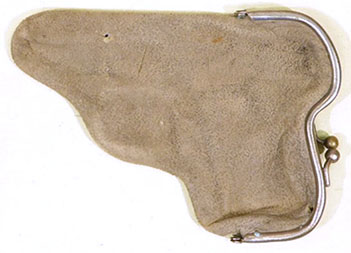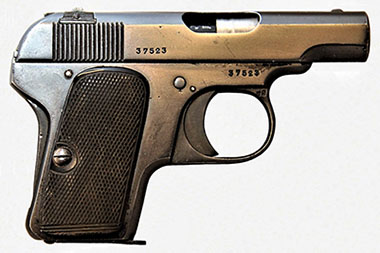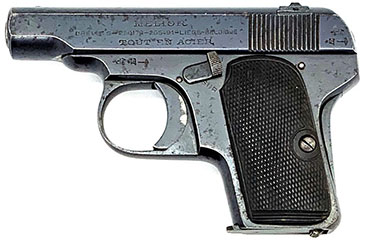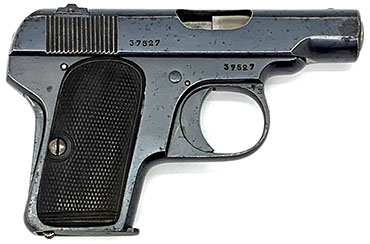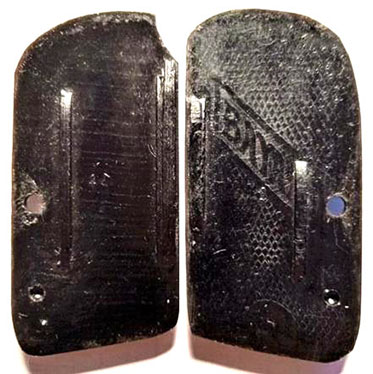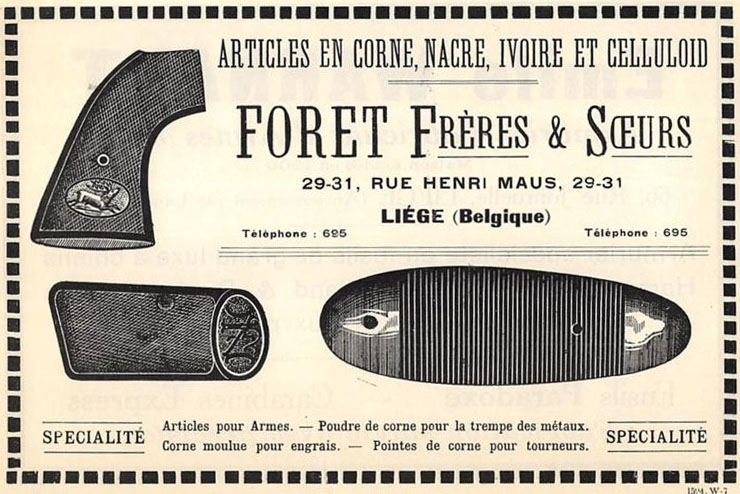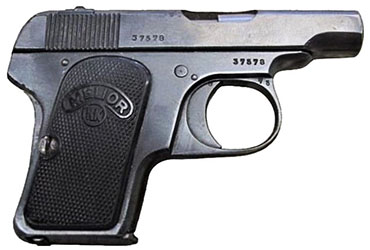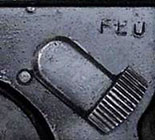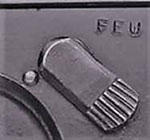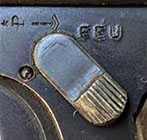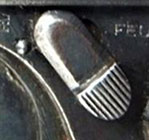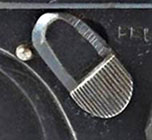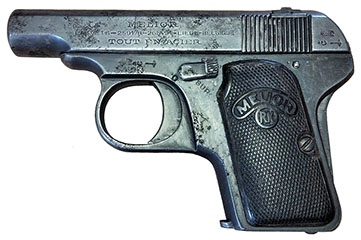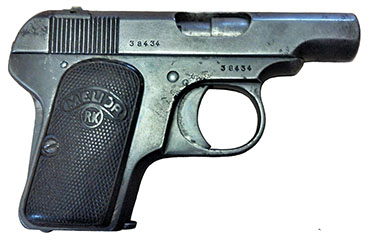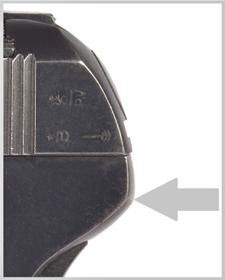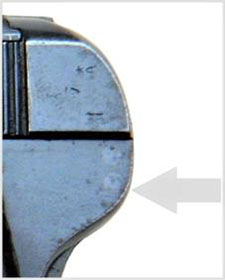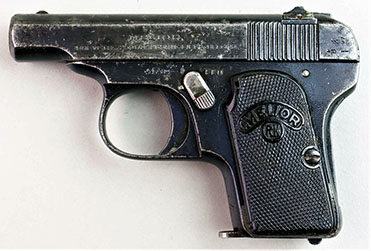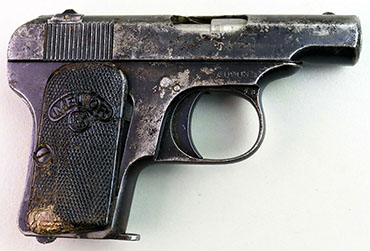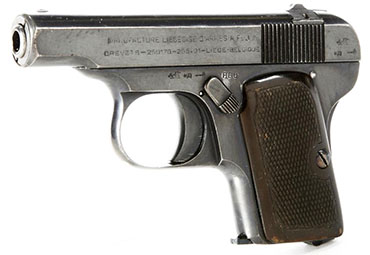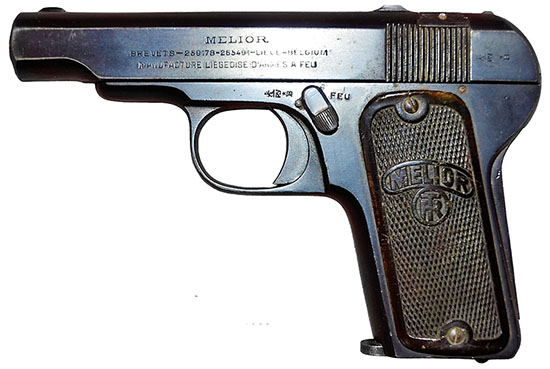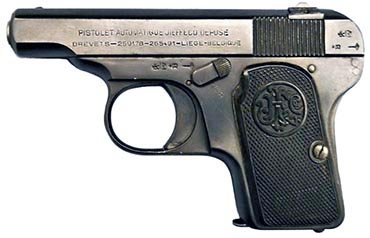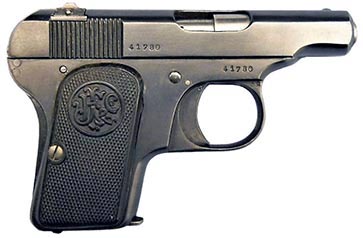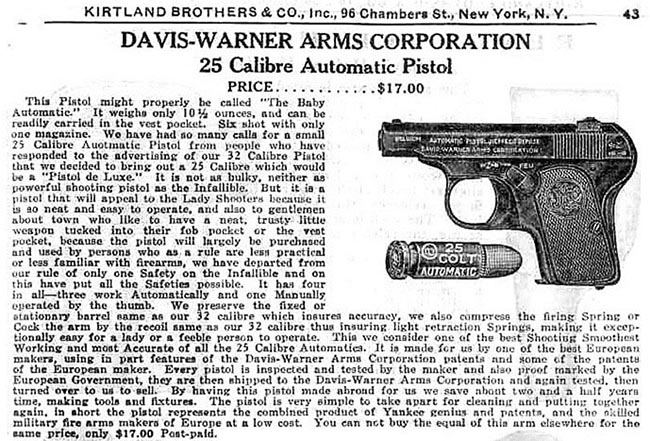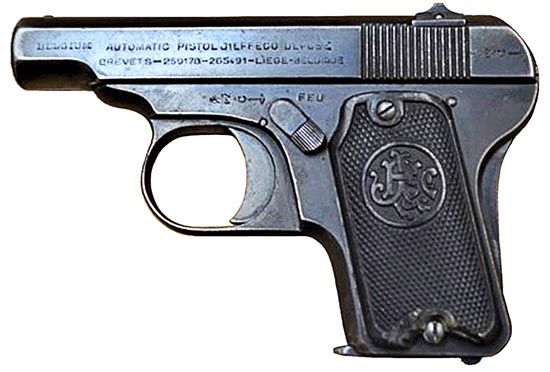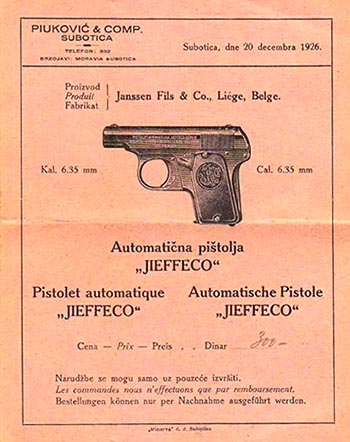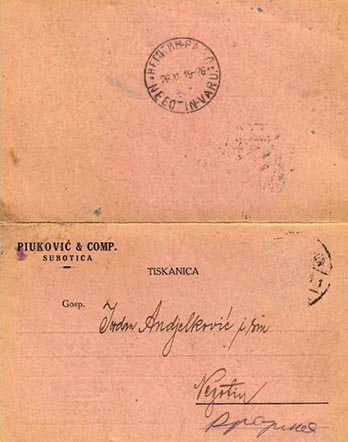 |
||||||||||||||||||||||||||||||||||||||||||||||||||||||||||||||||||||||||||||||||||||||||||||||||||||||||||||||||||||||||||||||||||||||||||||||||||||||||||||||||||||||||||||||||||||||||||||||||||||||||||||||||||||||||||||||||||||||||||||||||||||||||||||||||||||||||||||||||||||||||||||||||||||||||||||||||||||||||||||||||||||||||||||||||||||||||||||||||||||||||||||||
|
Model 1914 first variant type 3 pistols do not have a loaded chamber indicator on the slide. On the left side of the slide of the Melior first variant type 3 there is a three-line inscription: the first line denotes the name of the pistol, the second line has the numbers of the two Belgian patents of 1913 and 1914 on the basis of which this model was designed, and the third line has advertising slogan "Tout en Acier," meaning "All steel" in French. MELIOR
This inscription on the slides of Melior first variant pistols can be traced to serial number 38715. Pistols made with the Jieffeco brand have a similar three-line inscription in French and can be traced to the serial number 39015. PISTOLET AUTOMATIQUE JIEFFECO DEPOSE
Pistols of the French company "MAPF" were also sold under the brand "Le Tout Acier." This was done for "Establishments Lemasson," an arms shop in Paris. Establishments such as this arms shop often signed contracts with various gun manufacturers to produce their own brands of pistols. Therefore, presumably Melior and Jieffeco pistols with the inscription "Tout en Acier" were delivered to the "Establishments Lemasson" shop in Paris. Probably the intermediary between the company "MAPF" and the store "Establishments Lemasson" was a well-known Spanish distributor Eduardo Schilling from Barcelona.
Both of the earliest known Model 1914 Melior first variant type 3 pistols, with serial numbers 37523 and 37527, issued after the First World War, have identical grips made of horn, that lack the company trademark logo.
Presumably, Robar did not produce the grips themselves, but entrusted grip production to a company that specialized only in the manufacture of grips. This conclusion is made on the basis of a study of the grips for the Model 1914 first variation Melior pistol. These grips have an impression of the Bayard pistol logo on the reverse side, so clearly the company that manufactured these grips produced grips for other companies as well.
Probably Louis Robar ordered grip plates from the Liege company FORET Freres & Sceurs, which specialized in their manufacture from various materials, including horn.
The Melior pistol with the serial number 37578 already had factory grips with the company logo. This is the last of the studied pistols that had an "L" shaped safety lever (safety lever L-shaped). The shape of the safety lever was changed in the interval between serial number 37578 and serial number 38182.
During the study of all variations of the Model 1914, five types of safety levers were found. These safety levers differ in shape, number of serrations and design. The type 1 safety levers belong to the Model 1914 first variation types 1, 2, 3. The type 2 and 3 safety levers were used on the Model 1914 first variation types 4 and 5. The type 4 and 5 safety levers have a fundamentally different design and were used on the Model 1914 third variation.
Model 1914 First Variant Type 4 The observed Melior Model 1914 first variation type 4 pistols with serial numbers 38182, 38407, 38434, 38517, and 38797 have a type 2 safety lever. These Melior pistols have a three-line inscription on the slide with the slogan "Tout en Acier" and were sold on the French market : MELIOR
This is the last observed pistol of the first variation that has an angular frame shape at the rear. The frame shape change occurred in the range between serial numbers 38797 and 39015.
Basically, pistols of the first modification type 5 have a rounded frame form at the rear, but among the studied pistols of this type, starting with the serial number 39015, which has this rounded form, you can see pistols occasional pistols with a slightly sharper angle at the rear, for example, Melior serial number 40903.
On the pistols of the first variation type 5, you can see safety levers of both the second and third type, regardless of serial number order. Melior pistols of the first variation type 5 with serial numbers 40903, 41406 and 44012 were intended for the French and Belgian markets and have an inscription on the slide in French : MELIOR
The Melior pistol with the serial number 43912 intended for export to the English market has an additional export marking "Belgium" in the front of the slide : BELGIUM MELIOR
Special attention should be paid to the pistol of the first variation type 5 with the serial number 41765. This pistol has an inscription on the slide : MANUFACTURE LIEGEOISE D'ARMES A FEU
We can see the same marking on an enlarged copy of the Melior Model 1914 pistol in caliber 7.65, the production of which began around 1922. In this case, we see a three-line inscription where the name of the exporting company is added under the manufacturer's brand and patent numbers.
This inscription was made for the company "MANUFACTURE LIEGEOISE D'ARMES A FEU" which was a major exporter of weapons around the world and produced hunting rifles and revolvers. Apparently, the company "MANUFACTURE LIEGEOISE D'ARMES A FEU" never produced automatic
pistols, but exported pistols from Belgian and Spanish manufacturers under its own brand. We can find a similar inscription on the slides of Spanish Astra pistol, which were sold by the deal As mentioned above, the first known Jieffeco pistol of the first variation type 5 with the serial number 39015 had a three line inscription in French: PISTOLET AUTOMATIQUE JIEFFECO DEPOSE Jieffeco pistols of the first variation type 5 with serial numbers 40575, 40826, 41780, 42176, 42515, 42775, and 43926 were designed for the French and Belgian markets; they have an inscription on the slide in French: PISTOLET AUTOMATIQUE JIEFFECO DEPOSE
In addition to the French and Belgian markets, the Janssen Freres trading company exported Jieffeco pistols of the first type 5 modification to America. The earliest advertising of this model can be seen in the American catalog of 1920 of the Kirtland Brothers company located in New York, which was a sales agent for the Davis-Warner Arms Corporation, which in turn was the main importer of these pistols in the U.S.
The slide of the Jieffeco pistol, the image of which you see in this advertisement, has an additional export marking "Belgium" in the front of the slide, as well as a two-line inscription in English : AUTOMATIC PISTOL JIEFFECO DEPOSE In fact, such an inscription on the slide is not found on any Model 1914 first variation pistol made by the Louis Robar company, especially without patent numbers, despite the drawing in the advertisement. The import company, Davis-Warner Arms Corporation, which purchased pistols from Janssen Freres, deliberately concealed accurate data about the manufacturer for its own commercial purposes. Such an inscription with the export marking "Belgium" is found only on Jieffeco pistols of the second variation that do not have the name of the Davis-Warner Arms Corporation and whose production presumably began in early or mid-1920, so the Model 1914 second variation pistols may also be called the model 1920, and often are.
Slides with the name of this company appear a little later, probably at the end of 1920, and these pistols of the second modification have a three-line inscription indicating the place of production in English as well as patent numbers : AUTOMATIC PISTOL JIEFFECO MADE IN LIEGE-BELGIUM
I think it is necessary to highlight quotes from the text of this 1920 advertisement in order to understand the role of the Davis Warner Arms Corporation in the production of these pistols, as this is important for understanding the relationship of the Davis-Warner Arms with the Louis Robar company … We have had so many calls for a small 25 calibre automatic pistol from people who have responded to the advertising of our 32 calibre pistol that we decided to bring out a 25 calibre which would be a “pistol de luxe.” It is made for us by one of the best European makers, using in part features of the Davis-Warner arms corporation patents and some of the patents of the European maker. Every pistol is inspected and tested by the maker and also proof marked by the European government, they are then shipped to the Davis-Warner Arms Corporation and again tested, then turned over to us to sell. By having this pistol made abroad for us we save about two and a half years time, making tools and fixtures. The pistol is very simple to take apart for cleaning and putting together again, in short the pistol represents the combined product of Yankee genius and patents, and the skilled military fire arms makers of Europe at a low cost. That is, the Davis-Warner Arms Corporation claims that it is the initiator of the release of a 25-caliber pistol, which would be a “de luxe pistol,” and the fact that Louis Robar's company partially used the features of the patents of the Davis-Warner Arms Corporation. In speaking of genius, the Davis-Warner Arms Corporation probably means its entrepreneurial spirit. Regarding the patents of the Davis-Warner Arms Corporation, it is possible that the design engineer, Henry Rosier, who apparently also took part in the project of creating this model of the pistol in 1913, together with Louis Robar and Edmond Tat, and later at the beginning of the First World War emigrated first to England and then to America in 1917, may have collaborated with the Franklin B. Warner corporation. It was at this time in 1920 that Henry Rosier was living on Merrimack Street in Lowell, Massachusetts. (For more information, see the article The Rebirth of the Phoenix in Massachusetts) Probably Henry Rosier had a patent for fixing the barrel, since this system of fixing the barrel on two pins is not described in Belgian patents No. 259178 and No. 265491. And of course, it is quite likely that Henry Rosier could sell the rights to his inventions to the Davis-Warner Arms Corporation. Another interesting fact is that the 1920 instructions for Jieffeco pistols, which were supplied to the Davis-Warner arms Corporation along with pistols and advertising brochures of the Kirtland Brothers sales agent, have a synthesized image of the Jieffeco pistol, which includes images of pistols of the 1914 model of the first modification type 3 and pistols of the 1914 model of the second modification, which had grips with two screws. That is, in 1920, this instruction could be supplied both with the first modification of the type 3, and with the second modification. In this manual, the pistols of this model are named as the New Impoved Model. The same synthesized image of the Jieffeco pistol can be seen in the 1921 Italian advertisement of the company Napoleone & Vittorio Castelli, which was located in the city of Brescia and produced revolvers until 1928.
Also, the synthesized image of the Jieffeco pistol can be seen on the 1926 price list of the Serbian store "Piuković & Co." which in the 1920s sold various iron goods in the city of Subotica.
The production of Melior & Jieffeco Model 1914 second variation pistols, the grip plates of which were fastened with two screws, began in the range between serial numbers 44012 and 44344.
|
||||||||||||||||||||||||||||||||||||||||||||||||||||||||||||||||||||||||||||||||||||||||||||||||||||||||||||||||||||||||||||||||||||||||||||||||||||||||||||||||||||||||||||||||||||||||||||||||||||||||||||||||||||||||||||||||||||||||||||||||||||||||||||||||||||||||||||||||||||||||||||||||||||||||||||||||||||||||||||||||||||||||||||||||||||||||||||||||||||||||||||||
|
||||||||||||||||||||||||||||||||||||||||||||||||||||||||||||||||||||||||||||||||||||||||||||||||||||||||||||||||||||||||||||||||||||||||||||||||||||||||||||||||||||||||||||||||||||||||||||||||||||||||||||||||||||||||||||||||||||||||||||||||||||||||||||||||||||||||||||||||||||||||||||||||||||||||||||||||||||||||||||||||||||||||||||||||||||||||||||||||||||||||||||||
|
Copyright 2021 by Vaclav Vriesen. All rights reserved. |
||||||||||||||||||||||||||||||||||||||||||||||||||||||||||||||||||||||||||||||||||||||||||||||||||||||||||||||||||||||||||||||||||||||||||||||||||||||||||||||||||||||||||||||||||||||||||||||||||||||||||||||||||||||||||||||||||||||||||||||||||||||||||||||||||||||||||||||||||||||||||||||||||||||||||||||||||||||||||||||||||||||||||||||||||||||||||||||||||||||||||||||
|
|
||||||||||||||||||||||||||||||||||||||||||||||||||||||||||||||||||||||||||||||||||||||||||||||||||||||||||||||||||||||||||||||||||||||||||||||||||||||||||||||||||||||||||||||||||||||||||||||||||||||||||||||||||||||||||||||||||||||||||||||||||||||||||||||||||||||||||||||||||||||||||||||||||||||||||||||||||||||||||||||||||||||||||||||||||||||||||||||||||||||||||||||


